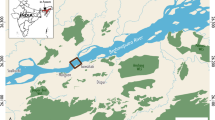Abstract
Entanglement in fishing gear occurs in endangered manatees and may result in serious injury or death. Such incidents may happen more frequently at night when the animal’s visual sense is limited. In this study, we examined the differences in behavioral response of captive manatees to a net obstacle during light (day) and dark (night) periods. We used a plastic net as the obstacle, and video-recorded the manatees’ behavior. The experiments showed that captive manatees avoided the obstacle during the day more frequently than at night, which suggests that the manatees can perceive the obstacle more readily during light periods. However, there was no difference in the frequency of bumping or actively touching the obstacle between light and dark periods. The results suggest that the manatees can recognize the net obstacle even at night by purposely touching it, but they avoid it less frequently, and that entanglement during light periods may occur during accidental bumping, rather than from a failure to recognize it altogether.

Similar content being viewed by others
References
Grech A, Marsh H, Coles R (2008) A spatial assessment of the risk to a mobile marine mammal from bycatch. Aquat Conserv Mar Freshw Ecosys 18:1127–1139
Reep RL, Bonde RK (2006) The Florida manatee: biology and conservation. University Press of Florida, Gainesville
de Thoisy B, Spiegelberger T, Rousseau S, Talvy G, Vogel I, Vie JC (2003) Distribution, habitat, and conservation status of the West Indian manatee Trichechus manatus in French Guiana. Oryx 37:431–436
Castelblanco-Martinez DN, Bermudez-Romero AL, Gomez-Camelo IV, Rosas FCW, Trujillo F, Zerda-Ordonez E (2009) Seasonality of habitat use, mortality and reproduction of the vulnerable Antillean manatee Trichechus manatus manatus in the Orinoco River, Colombia: implications for conservation. Oryx 43:235–242
Reeves RR, Tuboku-Metzger D, Kapindi RA (1988) Distribution and exploitation of manatees in Sierra Leone West Africa. Oryx 22:75–84
Silva MA, Araujo A (2001) Distribution and current status of the West African manatee (Trichechus senegalensis) in Guinea-Bissau. Mar Mammal Sci 17:418–424
Hartman DS (1979) Ecology and behavior of the manatee (Trichechus manatus) (Spec Publ 5). Am Soc Mammals, Lawrence
Beck CA, Barros NB (1991) The impact of debris on the Florida manatee. Mar Pollut Bull 22:508–510
Griebel U, Schmid A (1997) Brightness discrimination ability in the West Indian manatee (Trichechus manatus). J Exp Biol 200:1587–1592
Cohen JL, Tucker GS, Odell DK (1982) The photoreceptors of the West Indian manatee. J Morphol 173:197–202
Griebel U, Schmid A (1996) Color vision in the manatee (Trichechus manatus). Vision Res 36:2747–2757
Bauer GB, Colbert DE, Gaspard JCIII, Littlefield B (2003) Underwater visual acuity of Florida manatees (Trichechus manatus latirostris). Int J Comp Sociol Psychol 16:130–142
Marshall CD, Clark LA, Reep RL (1998) The muscular hydrostat of the Florida manatee (Trichechus manatus latirostris): a functional morphological model of perioral bristle use. Mar Mamm Sci 14:290–303
Reep RL, Marshall CD, Stoll ML, Whitaker DM (1998) Distribution and innervation of facial bristles and hairs in the Florida manatee (Trichechus manatus latirostris). Mar Mamm Sci 14:257–273
Bachteler D, Dehnhardt G (1999) Active touch performance in the Antillean manatee: evidence for a functional differentiation of facial tactile hairs. Zool 102:61–69
Reep RL, Stoll ML, Marshall CD, Homer BL, Samuelson DA (2001) Microanatomy of facial vibrissae in the Florida manatee: the basis for specialized sensory function and oripulation. Brain Behav Evol 58:1–14
Reep RL, Marshall CD, Stoll ML (2002) Tactile hairs on the postcranial body in Florida manatees: a mammalian lateral line? Brain Behav Evol 59:141–154
Marshall CD, Maeda H, Iwata M, Furuta M, Asano S, Rosas F, Reep RL (2003) Orofacial morphology and feeding behaviour of the dugong, Amazonian, West African and Antillean manatees (Mammalia: Sirenia): functional morphology of the muscular–vibrissal complex. J Zool 259:245–260
Acknowledgments
We would like to thank all of the staff at the Okinawa Churaumi Aquarium for their assistance in conducting these experiments. We would like to thank K. Asahina at Nihon University, H. Kato at Tokyo University of Marine Science and Technology, L. D. Olivera-Gomez at the Autonomous University Juarez of Tabasco, and D. Gonzalez-Socoloske at Duke University for their discussions and insightful comments on previous drafts. We also thank J. A. Mobley and D. Gonzalez-Socoloske for correcting the English manuscript. The present study was supported by the Fisheries Research Agency, National Research Institute of Far Seas Fisheries.
Author information
Authors and Affiliations
Corresponding author
Rights and permissions
About this article
Cite this article
Kikuchi, M., Suzuki, M., Ueda, K. et al. The differences in behavioral responses to a net obstacle between day and night in captive manatees; does entanglement happen at night?. Fish Sci 77, 795–798 (2011). https://doi.org/10.1007/s12562-011-0388-x
Received:
Accepted:
Published:
Issue Date:
DOI: https://doi.org/10.1007/s12562-011-0388-x




